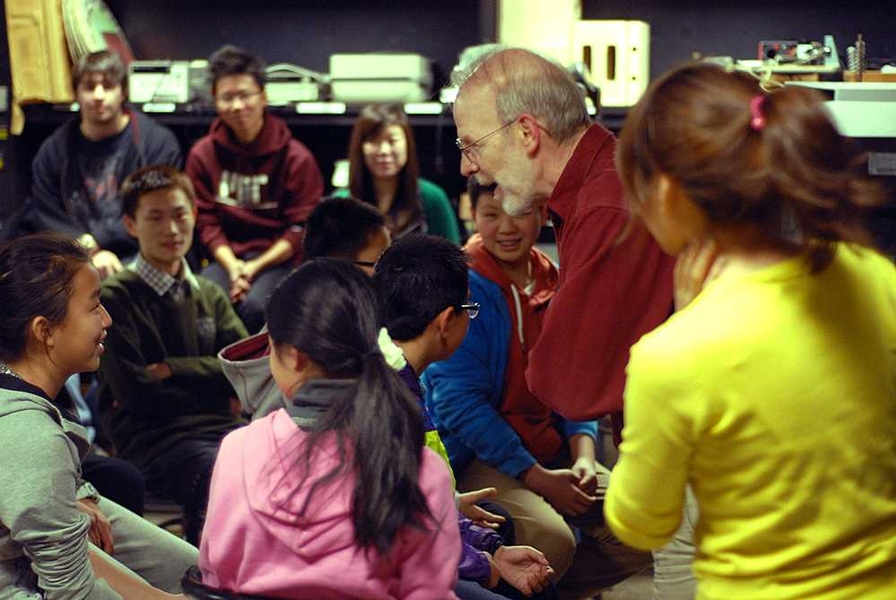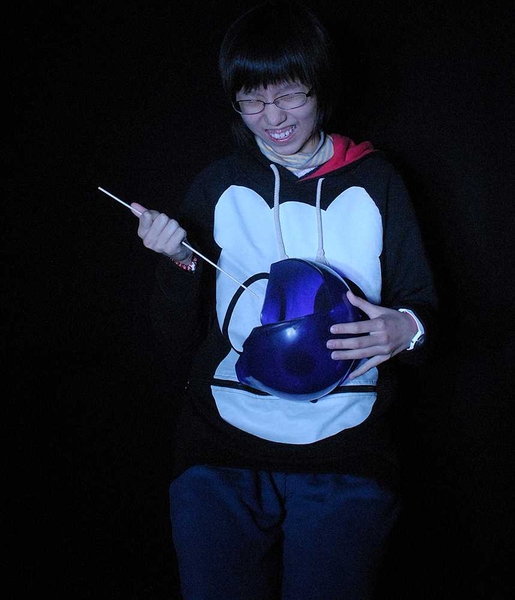Edgerton instructors Ed Moriarty, Alban Cobi and Jessica Garrett spent ten days this month leading two groups of 32 middle and high school students from Beijing, China, in science and engineering projects. Assisted by MIT and Wellesley students, as well as an MIT alumnus, each group spent five intensive days building LED light boxes with integrated circuits, experimenting with high-speed photography, learning about sound and experimenting with speakers.
“Chinese students are very grateful that MIT opened the door to them,” said Pei Zhang, executive director of the US China Scitech Education Promotion Association and organizer of the visit. “The students achieved more than they expected. Not only did these students gain a new perspective on how to connect science with the real world, but they also surpassed a learning curve by learning in a completely different cultural environment.”
Moriarty’s teaching method ran counter to what the students were accustomed to in Beijing. He encouraged the students to talk to each other and ask questions, even if they weren’t quite sure how to do so in English. “Students were very quiet at first, and I wondered if it was even possible, but by the last day, we could barely get them out on time because they had so much to share,” Moriarty said.
“When you see the instructor (Ed Moriarty) teaching on top of [a] table with a loyal dog (Rookie), you instantly get the idea ‘that everything is possible,’” a student said.
The students were astonished that science and engineering could be fun, Zhang noted. And along with the fun, there was much to be learned. "Wisdom talk" is how one student referred to the classroom discussions about engineering concepts. Crucially important was the assistance of interpreter and mentor Xubo Sun ’16, who translated from Mandarin to English and English to Mandarin.
Their visit culminated with a day of acoustics experiments ranging from oobleck and laser pointers on speakers, to a stunning “light harp” built with laser pointers and light sensors that plays music when the light is blocked. When viewed in the dark with a smoke machine illuminating the red lasers, it provides a gorgeous lesson in light and sound.
Students cheered when Tommy Moriarty ’14 of the MIT Logs sang and recorded a song for them in English and then allowed the students to record songs of their own in Mandarin. He shared his knowledge of recording and added various vocal enhancements to the songs according to the students’ wishes.
As a result of this experience, the students now see MIT as their target school in the future. When told by Zhang that not everyone can get into MIT, the students replied: “Who is afraid of risk? Failure is part of the engineering.”
“Chinese students are very grateful that MIT opened the door to them,” said Pei Zhang, executive director of the US China Scitech Education Promotion Association and organizer of the visit. “The students achieved more than they expected. Not only did these students gain a new perspective on how to connect science with the real world, but they also surpassed a learning curve by learning in a completely different cultural environment.”
Moriarty’s teaching method ran counter to what the students were accustomed to in Beijing. He encouraged the students to talk to each other and ask questions, even if they weren’t quite sure how to do so in English. “Students were very quiet at first, and I wondered if it was even possible, but by the last day, we could barely get them out on time because they had so much to share,” Moriarty said.
“When you see the instructor (Ed Moriarty) teaching on top of [a] table with a loyal dog (Rookie), you instantly get the idea ‘that everything is possible,’” a student said.
The students were astonished that science and engineering could be fun, Zhang noted. And along with the fun, there was much to be learned. "Wisdom talk" is how one student referred to the classroom discussions about engineering concepts. Crucially important was the assistance of interpreter and mentor Xubo Sun ’16, who translated from Mandarin to English and English to Mandarin.
Their visit culminated with a day of acoustics experiments ranging from oobleck and laser pointers on speakers, to a stunning “light harp” built with laser pointers and light sensors that plays music when the light is blocked. When viewed in the dark with a smoke machine illuminating the red lasers, it provides a gorgeous lesson in light and sound.
Students cheered when Tommy Moriarty ’14 of the MIT Logs sang and recorded a song for them in English and then allowed the students to record songs of their own in Mandarin. He shared his knowledge of recording and added various vocal enhancements to the songs according to the students’ wishes.
As a result of this experience, the students now see MIT as their target school in the future. When told by Zhang that not everyone can get into MIT, the students replied: “Who is afraid of risk? Failure is part of the engineering.”








